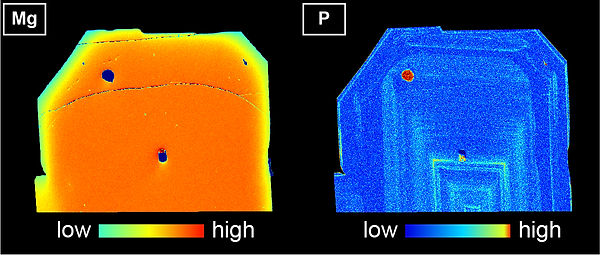Preservation of magma recharge signatures in olivine during protracted storage
Geochemical characterization of olivine crystals is a valuable petrological tool that provides clues into the composition of primitive (Mg-rich) basaltic melts. Olivine from three recent Kīlauea eruptions (2008 and 2020 Halemaʻumaʻu lava lake at the Kīlauea summit, 2018 lower East Rift Zone) are analyzed for their iron (Fe), magnesium (Mg) and phosphorus (P) compositions. Analyzing concentration changes in slow diffusing elements like P in olivine and in fast diffusing elements like Fe-Mg helps to understand growth, dissolution, and diffusive re-equilibration cycles in the crystals. These cycles are inferred to have been caused by magma intrusions for all three eruptions.
-01.jpg)
Figure adapted from Mourey et al. (2023): Example of olivine from Kilauea with growth and dissolution features observed in phosphorus
I developed an interpretative framework that incorporates the disparate patterns of chemical heterogeneity revealed in the chemical maps of sectioned olivine crystals. Using numerical diffusion models, we evaluate how the frequency of Mg-rich primitive intrusions, the size of the olivine crystals, and crystal sectioning affect the Fe-Mg content within a given olivine population. We show that the variable compositions of olivine crystals erupted in Kīlauea lavas cannot result from remobilization of century-old crystal mush

Figure (from Mourey et al., 2023): Interpretation of the X-ray maps based on P zoning and Fe-Mg diffusion models. The dissolution front in the olivine are explained in 4 steps: (1) a high-Fo olivine crystallized in a hot primitive melt in the edifice/crust; (2) The crystal cargo from a first intrusion is dissolved during storage in the summit reservoirs; (3) A new rim is formed after a second intrusion of magma, and diffusion erases (in ~3 months) the signal in Fe-Mg; (4) The magma from the summit is mixed with the magma from the East Rift Zone shortly prior to or during the eruption, a final rim Fo75 crystallizes (during cooling), and diffusive re-equilibration occurs.
Finally, we explored the question: how long can an olivine crystal survive within hot magma reservoirs at Kilauea without having its original chemical information erased by element diffusion, which tends to smear out this signal? Various studies proposed that olivine populations erupted in basaltic lavas represent decades to century long cargo accumulated in reservoirs. Our study of 2008, 2018, and 2020 olivine crystals coupled with sophisticated diffusion models show that this is not the case: olivine compositions do not survive more than a few years under magmatic conditions (Figure below).

Figure from Mourey et al. (2023): How long can an olivine crystal preserve its original Fe-Mg composition (Fo=Mg/[Mg+Fe]) by sitting in magmas at different temperatures? The modeling and corresponding data (round symbols from 2018 Kilauea olivine) suggest only a few years at best. The variability in olivine composition we therefore see nearly ubiquitously in basalt at Kilauea can only be from recent crystals arriving into the system, not from decades to century-long periods as previously suggested.
Phosphorus and aluminium in olivine
A set of magma cooling and crystallization experiments were used to study how two trace elements (P, Al) are incorporated and 'zoned' in olivine. The discovery less than a decade prior to the onset of this project that these trace elements provided blueprints of the growth history of olivine was a gamechanger: crystal growth sequences could be read simply by chemically mapping a crystal. We sough to find out why these blueprints appear as remarkable oscillations in the concentration of P in particular (see Figure below). We found that it doesn't take very rapid crystal growth to incorporate anomalously high amounts of P in the olivine structure, meaning that these blueprints should be available in most natural olivine growing at moderate to high rates.

Figure (adapted from Shea et al., 2019): Electron microprobe X-ray maps of P and Al in experimentally grown olivine. Experimental magmas are cooled by 60 degrees and left to crystallize for 1.5 (top) and 6 hours (bottom). Growing olivine shows clear enrichment in the two trace elements, confirming that rapid growth is responsible for anomalous incorporation of P and Al during crystallization. Previous models have suggested that these elements are rejected from the growing crystal (incompatible behavior), and thus accumulated in a P- and Al- rich boundary layer around the olivine. While this is certainly true for Al, our results demonstrate that the two elements are enriched by different mechanisms.
If interested in learning more, take a look at Shea et al. (2019).
Publication: Shea T., Hammer J.E., Hellebrand E., Mourey A.J., Costa F., First E., Lynn K.J. (2019). Phosphorus and aluminum zoning in olivine: contrasting behavior of two nominally incompatible trace elements. Contribution Mineralogy and Petrology 174:85
Fe-Mg partitioning in olivine
A set of cooling experiments investigated whether growing olivine changes its composition from core to rim in Fe-Mg as the surrounding magma crystallizes and loses these components. Our results showed that in fact little chemical zoning occurs in these elements because both are depleted to comparable extents around a rapidly growing olivine crystal. This observation is critical for our understanding of the Fe-Mg record because olivine is the mineral most used to calculate magma compositions and temperatures.

Figure adapted from Shea et al. in press: Olivine crystals with largely homogeneous Mg compositions (Mg olivine maps) surrounded by basalt liquid. Mg-poor boundary layers are thin (yellow thin halos in middle image). By contrast, phosphorus shows clear growth-related zoning.